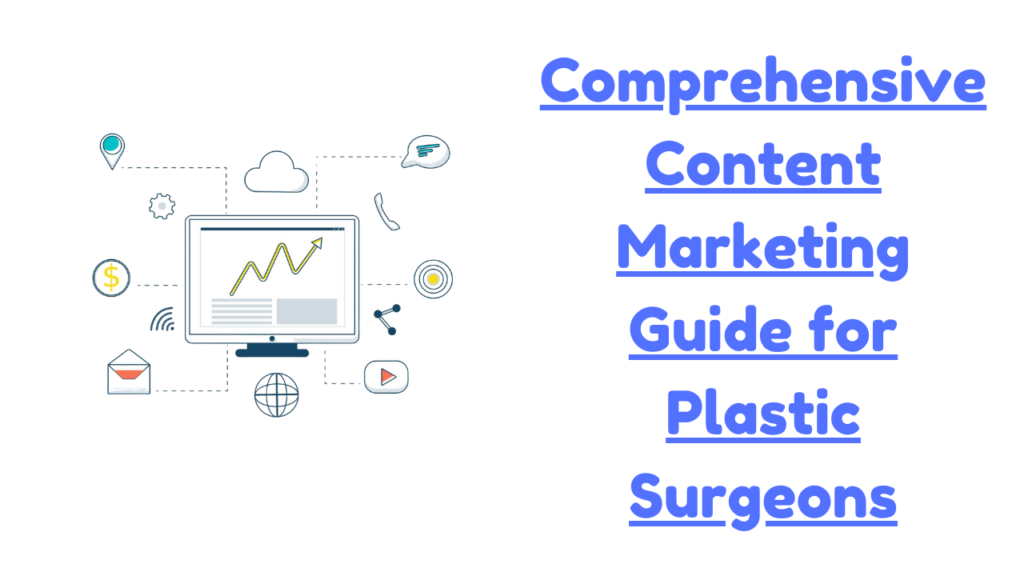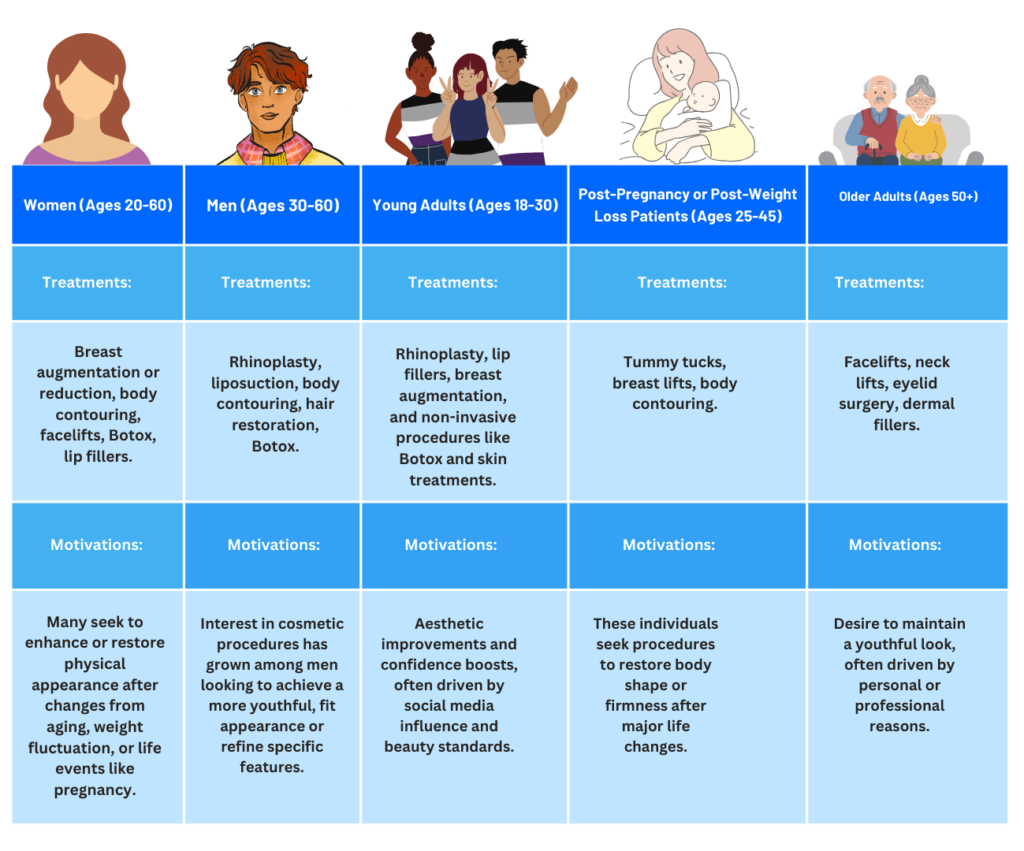"Content Marketing for Plastic Surgeons: Attract and Engage More Patients"
Content marketing for plastic surgeons is a powerful tool for plastic surgeons, helping to attract new patients, build trust, and establish authority in the industry.
A well-thought-out content marketing strategy can position your practice as the go-to source for expert care.
Below is a step-by-step guide to building a robust content marketing plan specifically for plastic surgeons.
The Benefits of Content Marketing for Plastic Surgeons
Content marketing is a powerful way for plastic surgeons to grow their practice and connect with their target audience.
By crafting high-quality, patient-focused content, surgeons can improve their search engine visibility while amplifying the effectiveness of their overall marketing efforts.
A well-executed content strategy not only drives traffic to their website and social media channels but also engages prospective patients by providing valuable insights into aesthetic procedures.
This approach helps attract highly qualified leads while establishing the surgeon’s authority and credibility in the field.
With a strategic plan in place, plastic surgeons can ensure their content reaches the right audience with the right message at the right time, maximizing impact and helping their practice stand out in a competitive industry.

1. Define Your Target Audience
Before creating any content, it’s essential to understand who you’re targeting. You need to know the demographics, needs, and concerns of your ideal patient to craft content that resonates with them.
Key Factors:
- Demographics: Age, gender, income level, location
- Psychographics: Lifestyle, motivations, pain points
- Services: What specific treatments (e.g., rhinoplasty, liposuction, breast augmentation) are your patients seeking?
Example: If your focus is on women aged 30-50 looking for anti-aging treatments, create content that answers their specific concerns about procedures like facelifts, Botox, or dermal fillers.

2. Set Clear Goals
Determine the main objectives of your content marketing efforts. This could include:
- Increasing website traffic
- Improving patient lead generation
- Enhancing online visibility and brand awareness
- Establishing yourself as an industry authority.
3. Content Audit & Competitor Research
Review your existing content to determine what has worked and what needs improvement. Analyze your competitors’ content strategies to identify gaps you can fill or opportunities for differentiation.
Key Metrics to Assess:
- Top-performing blog posts
- Most shared social media content
- SEO rankings of key competitors
- Topics competitors are not covering
Tools for Competitor Research:
- Ahrefs, SEMrush: To identify top-ranking content
- Buzzsumo: To analyze the most shared content in your industry.
4. Develop Content Pillars
Content pillars are the main topics around which all of your content will be built. For plastic surgeons, these pillars could cover the various services you offer, patient concerns, and the patient journey.
Common Content Pillars for Plastic Surgeons:
- Cosmetic Procedures: Rhinoplasty, breast augmentation, facelifts
- Non-Surgical Treatments: Botox, fillers, laser treatments
- Patient Education: Surgery preparation, recovery tips, FAQ
- Success Stories: Patient testimonials, before-and-after photos
- Industry Trends: Latest developments in plastic surgery, new technology.
5. Create a Content Calendar
A content calendar helps you stay organized and consistent. Plan out blog posts, social media updates, videos, and email newsletters around your content pillars.
Example Calendar Structure:
- Weekly Blog Post: “Everything You Need to Know About Rhinoplasty Recovery”
- Daily Social Media Post: Share before-and-after images or testimonials
- Monthly Video: A Q&A on the most frequently asked patient questions
- Quarterly E-Book or Guide: “10 Steps to Prepare for Your Plastic Surgery Procedure”
Use tools like Trello or Asana to schedule content creation and publishing.
6. Optimize for SEO
Search Engine Optimization (SEO) is key to making your content visible to potential patients. The goal is to rank higher in search results for key terms related to plastic surgery.
Key Steps for SEO Optimization:
- Keyword Research: Use tools like Google Keyword Planner and Ahrefs to find relevant keywords like “best plastic surgeon near me,” “facelift cost,” or “rhinoplasty recovery.”
- On-Page SEO: Include keywords in titles, headings, meta descriptions, and image alt tags.
- Internal Linking: Link related blog posts and pages to create a web of valuable content on your site.
- Local SEO: Include location-based keywords and set up a fully optimized Google My Business profile.
Example Blog Post Structure:
- Title: “Top 5 Questions About Breast Augmentation Recovery, Answered”
- Focus Keyword: “Breast Augmentation Recovery”
- Subheadings: Answering common patient questions.
7. Use Different Content Formats
Diversify your content types to appeal to different audience segments. Some patients may prefer watching a video over reading a blog post, while others may be more engaged by social media posts.
Content Formats:
- Blog Posts: Educational articles on surgical procedures, recovery tips, etc.
- Videos: Surgery walkthroughs, interviews with the surgeon, patient testimonials
- Infographics: Easy-to-digest, visual information on procedure steps or benefits
- Webinars/Q&A Sessions: Live discussions where potential patients can ask questions about procedures
- Email Newsletters: Regular updates about your practice, promotions, and new content
Example: Create a YouTube video walking potential patients through the process of a rhinoplasty consultation, then share the video across your social media channels and in your email newsletter.




8. Leverage Patient Testimonials and Case Studies
Social proof is crucial in the medical field. Highlighting positive patient experiences and showcasing before-and-after results builds trust with potential clients.
How to Use Testimonials Effectively:
- Video Testimonials: Record patient stories after successful procedures.
- Case Studies: Document detailed accounts of the patient’s journey from consultation to recovery, including their results.
- Before-and-After Galleries: Display visual results prominently on your website and social channels.
9. Amplify Your Content with Paid Advertising
Use paid advertising to get more eyes on your content. Facebook Ads and Google Ads are highly effective for driving traffic to your website and promoting specific services.
Key Tactics:
- Facebook Ads: Target audiences based on demographics, interests, and location, promoting blog posts or videos that educate about specific procedures.
- Google Ads: Run search ads that show when users search for procedures like “best rhinoplasty surgeon” or “liposuction near me.”
10. Analyze and Adjust
Regularly track and assess your content performance using tools like Google Analytics, SEMrush, or Hootsuite. Monitor key metrics such as:
- Website traffic
- Engagement (likes, shares, comments)
- Conversion rates (how many people book consultations or contact your practice)
Use the data to adjust your content strategy. If one type of content, like patient testimonials, is driving the most traffic or conversions, create more of that type of content.
Conclusion: Why Content Marketing Works for Plastic Surgeons
Content marketing is more than just creating blog posts or videos—it’s about establishing authority, building trust, and providing value to potential patients.
When plastic surgeons implement a well-rounded content marketing strategy that educates, informs, and engages their audience, they not only attract more patients but also cultivate long-term relationships that lead to repeat business and referrals.
By staying consistent, optimizing for search, and continuously analyzing performance, your content marketing efforts can drive significant growth for your practice.

About the Author: Jatin Thakur
Jatin Thakur, founder of Aesthetics Sprints, is a seasoned digital marketer with 8+ years of experience helping plastic surgeons attract patients and grow their practices. Specializing in Local SEO, PPC Ads, and Social media marketing strategy, Jatin empowers aesthetic professionals to thrive in a competitive market.
FAQs on Plastic Surgery
1. Who is the target market for plastic surgery?
2. Can you advertise plastic surgery?
3. Does social media promote plastic surgery?
4. What is the most requested face plastic surgery?
5. Does Gen Z get more plastic surgery?
6. What is the latest plastic surgery trend?
"Ready to Attract More Patients to Your Practice?"
Grow your practice with tailored marketing that attracts and converts the right patients. From building your online presence to crafting high-converting campaigns, we specialize in driving real results for plastic surgeons.



